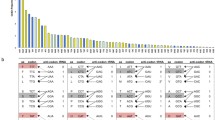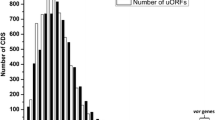Abstract
Regulation of gene expression in the malaria parasite Plasmodium falciparum is tightly controlled and little is known about the many steps involved. One step i.e. translation initiation is also poorly understood and in P. falciparum, choice of the translation initiation site (TIS) is a critical decision largely due to the high frequency of AUGs in the relatively long 5′ untranslated regions of parasite mRNAs. The sequences surrounding the TIS have a major role to play in translation initiation and this report evaluates these sequences by mutational analysis of the heat shock protein 86 gene, transient transfection and reporter assays in the parasite. We find that purines at the −3 and +4 positions are essential for efficient translation in P. falciparum, similar to other eukaryotes. Interestingly, a U at the −1 position results in 2.5-fold higher reporter activity compared to wild type. Certain classes of protein biosynthetic genes show higher frequencies of U at the −1 position, suggesting that these genes may exhibit higher levels of translation. This work defines the optimal sequences for TIS choice and has implications for the design of efficient expression vectors in an important human pathogen.


Similar content being viewed by others
References
Kozak M (1986) Point mutations define a sequence flanking the AUG initiator codon that modulates translation by eukaryotic ribosomes. Cell 44(2):283–292
Kozak M (2002) Pushing the limits of the scanning mechanism for initiation of translation. Gene 299(1–2):1–34
Thummel KE, Kharasch ED, Podoll T, Kunze K (1993) Human liver microsomal enflurane defluorination catalyzed by cytochrome p-450 2e1. Drug Metab Dispos 21(2):350–357
Kozak M (1999) Initiation of translation in prokaryotes and eukaryotes. Gene 234(2):187–208
Seeber F (1997) Consensus sequence of translational initiation sites from Toxoplasma gondii genes. Parasitol Res 83(3):309–311
Kozak M (1991) Structural features in eukaryotic mRNAs that modulate the initiation of translation. J Biol Chem 266(30):19867–19870
Kozak M (1984) Point mutations close to the AUG initiator codon affect the efficiency of translation of rat preproinsulin in vivo. Nature 308(5956):241–246
Joshi CP, Zhou H, Huang X, Chiang VL (1997) Context sequences of translation initiation codon in plants. Plant Mol Biol 35(6):993–1001
Cavener DR, Ray SC (1991) Eukaryotic start and stop translation sites. Nucleic Acids Res 19(12):3185–3192
Cigan AM, Pabich EK, Donahue TF (1988) Mutational analysis of the HIS4 translational initiator region in Saccharomyces cerevisiae. Mol Cell Biol 8(7):2964–2975
Cigan AM, Donahue TF (1987) Sequence and structural features associated with translational initiator regions in yeast—a review. Gene 59(1):1–18
Feng Y, Gunter LE, Organ EL, Cavener DR (1991) Translation initiation in Drosophila melanogaster is reduced by mutations upstream of the AUG initiator codon. Mol Cell Biol 11(4):2149–2153
Chen SJ, Ko CY, Yen CW, Wang CC (2009) Translational efficiency of redundant ACG initiator codons is enhanced by a favorable sequence context and remedial initiation. J Biol Chem 284(2):818–827
Peri S, Pandey A (2001) A reassessment of the translation initiation codon in vertebrates. Trends Genet 17(12):685–687
Clayton CE (2002) Life without transcriptional control? From fly to man and back again. EMBO J 21(8):1881–1888
Clayton C, Shapira M (2007) Post-transcriptional regulation of gene expression in Trypanosomes and Leishmanias. Mol Biochem Parasitol 156(2):93–101
Clayton C, Schwede A, Stewart M, Robles A, Benz C, Po J, Wurst M, Queiroz R, Archer S (2008) Control of mRNA degradation in Trypanosomes. Biochem Soc Trans 36(Pt 3):520–521
Lukes J, Paris Z, Regmi S, Breitling R, Mureev S, Kushnir S, Pyatkov K, Jirku M, Alexandrov KA (2006) Translational initiation in Leishmania tarentolae and Phytomonas serpens (Kinetoplastida) is strongly influenced by pre-ATG triplet and its 5′ sequence context. Mol Biochem Parasitol 148(2):125–132
Sullivan ML, Green PJ (1993) Post-transcriptional regulation of nuclear-encoded genes in higher plants: the roles of mRNA stability and translation. Plant Mol Biol 23(6):1091–1104
Saul A, Battistutta D (1990) Analysis of the sequences flanking the translational start sites of Plasmodium falciparum. Mol Biochem Parasitol 42(1):55–62
Yamauchi K (1991) The sequence flanking translational initiation site in protozoa. Nucleic Acids Res 19(10):2715–2720
Gardner MJ, Hall N, Fung E, White O, Berriman M, Hyman RW, Carlton JM, Pain A, Nelson KE, Bowman S, Paulsen IT, James K, Eisen JA, Rutherford K, Salzberg SL, Craig A, Kyes S, Chan MS, Nene V, Shallom SJ, Suh B, Peterson J, Angiuoli S, Pertea M, Allen J, Selengut J, Haft D, Mather MW, Vaidya AB, Martin DM, Fairlamb AH, Fraunholz MJ, Roos DS, Ralph SA, McFadden GI, Cummings LM, Subramanian GM, Mungall C, Venter JC, Carucci DJ, Hoffman SL, Newbold C, Davis RW, Fraser CM, Barrell B (2002) Genome sequence of the human malaria parasite Plasmodium falciparum. Nature 419(6906):498–511
Watanabe J, Sasaki M, Suzuki Y, Sugano S (2002) Analysis of transcriptomes of human malaria parasite Plasmodium falciparum using full-length enriched library: identification of novel genes and diverse transcription start sites of messenger RNAs. Gene 291(1–2):105–113
Patakottu BR, Mamidipally CS, Patankar S, Noronha S (2009) In silico analysis of translation initiation sites from P. falciparum. Online Journal of Bioinformatics 10(2):259–279
Militello KT, Dodge M, Bethke L, Wirth DF (2004) Identification of regulatory elements in the Plasmodium falciparum genome. Mol Biochem Parasitol 134(1):75–88
Banumathy G, Singh V, Pavithra SR, Tatu U (2003) Heat shock protein 90 function is essential for Plasmodium falciparum growth in human erythrocytes. J Biol Chem 278(20):18336–18345
Trager W, Jensen JB (1976) Human malaria parasites in continuous culture. Science 193(4254):673–675
Lambros C, Vanderberg JP (1979) Synchronization of Plasmodium falciparum erythrocytic stages in culture. J Parasitol 65(3):418–420
Fidock DA, Wellems TE (1997) Transformation with human dihydrofolate reductase renders malaria parasites insensitive to WR99210 but does not affect the intrinsic activity of proguanil. Proc Natl Acad Sci USA 94(20):10931–10936
Deitsch K, Driskill C, Wellems T (2001) Transformation of malaria parasites by the spontaneous uptake and expression of DNA from human erythrocytes. Nucleic Acids Res 29(3):850–853
Rangan L, Vogel C, Srivastava A (2008) Analysis of context sequence surrounding translation initiation site from complete genome of model plants. Mol Biotechnol 39(3):207–213
Stanton JD, Mensa-Wilmot K (2006) AUG-proximal nucleotides regulate protein synthesis in Leishmania tropica. Mol Microbiol 61(3):691–703
Danckwardt S, Neu-Yilik G, Thermann R, Frede U, Hentze MW, Kulozik AE (2002) Abnormally spliced beta-globin mRNAs: a single point mutation generates transcripts sensitive and insensitive to nonsense-mediated mRNA decay. Blood 99(5):1811–1816
Choong CS, Quigley CA, French FS, Wilson EM (1996) A novel missense mutation in the amino-terminal domain of the human androgen receptor gene in a family with partial androgen insensitivity syndrome causes reduced efficiency of protein translation. J Clin Invest 98(6):1423–1431
Agarwal S, Jha S, Sanyal I, Amla DV (2009) Effect of point mutations in translation initiation context on the expression of recombinant human alpha(1)-proteinase inhibitor in transgenic tomato plants. Plant Cell Rep 28(12):1791–1798
Yun DF, Laz TM, Clements JM, Sherman F (1996) mRNA sequences influencing translation and the selection of AUG initiator codons in the yeast Saccharomyces cerevisiae. Mol Microbiol 19(6):1225–1239
Signori E, Bagni C, Papa S, Primerano B, Rinaldi M, Amaldi F, Fazio VM (2001) A somatic mutation in the 5′UTR of BRCA1 gene in sporadic breast cancer causes down-modulation of translation efficiency. Oncogene 20(33):4596–4600
Tian C, Qin W, Li L, Zheng W, Qiu F (2010) A common polymorphism in CD40 Kozak sequence (−1C/T) is associated with acute coronary syndrome. Biomed Pharmacother 64(3):191–194
Gonzalez-Conejero R, Corral J, Roldan V, Martinez C, Marin F, Rivera J, Iniesta JA, Lozano ML, Marco P, Vicente V (2002) A common polymorphism in the annexin V Kozak sequence (−1C>T) increases translation efficiency and plasma levels of annexin V, and decreases the risk of myocardial infarction in young patients. Blood 100(6):2081–2086
Acknowledgments
BRP and PKS acknowledge the Indian Institute of Technology Bombay and the Council of Scientific and Industrial Research (CSIR) for their PhD fellowships. SP acknowledges the Board for Research in Nuclear Sciences (BRNS) for funding granted to this project. PM group is financially supported by the International Centre for Genetic Engineering and Biotechnology (ICGEB) and the Department of Biotechnology (DBT). We thank Drs. Kevin Militello and Dyann Wirth, Harvard School of Public Health for sharing the Pf86 and Renilla luciferase vectors. We also thank the reviewers of the manuscript for their careful reading of the manuscript and excellent suggestions for improvement.
Author information
Authors and Affiliations
Corresponding author
Rights and permissions
About this article
Cite this article
Patakottu, B.R., Singh, P.K., Malhotra, P. et al. In vivo analysis of translation initiation sites in Plasmodium falciparum . Mol Biol Rep 39, 2225–2232 (2012). https://doi.org/10.1007/s11033-011-0971-3
Received:
Accepted:
Published:
Issue Date:
DOI: https://doi.org/10.1007/s11033-011-0971-3




